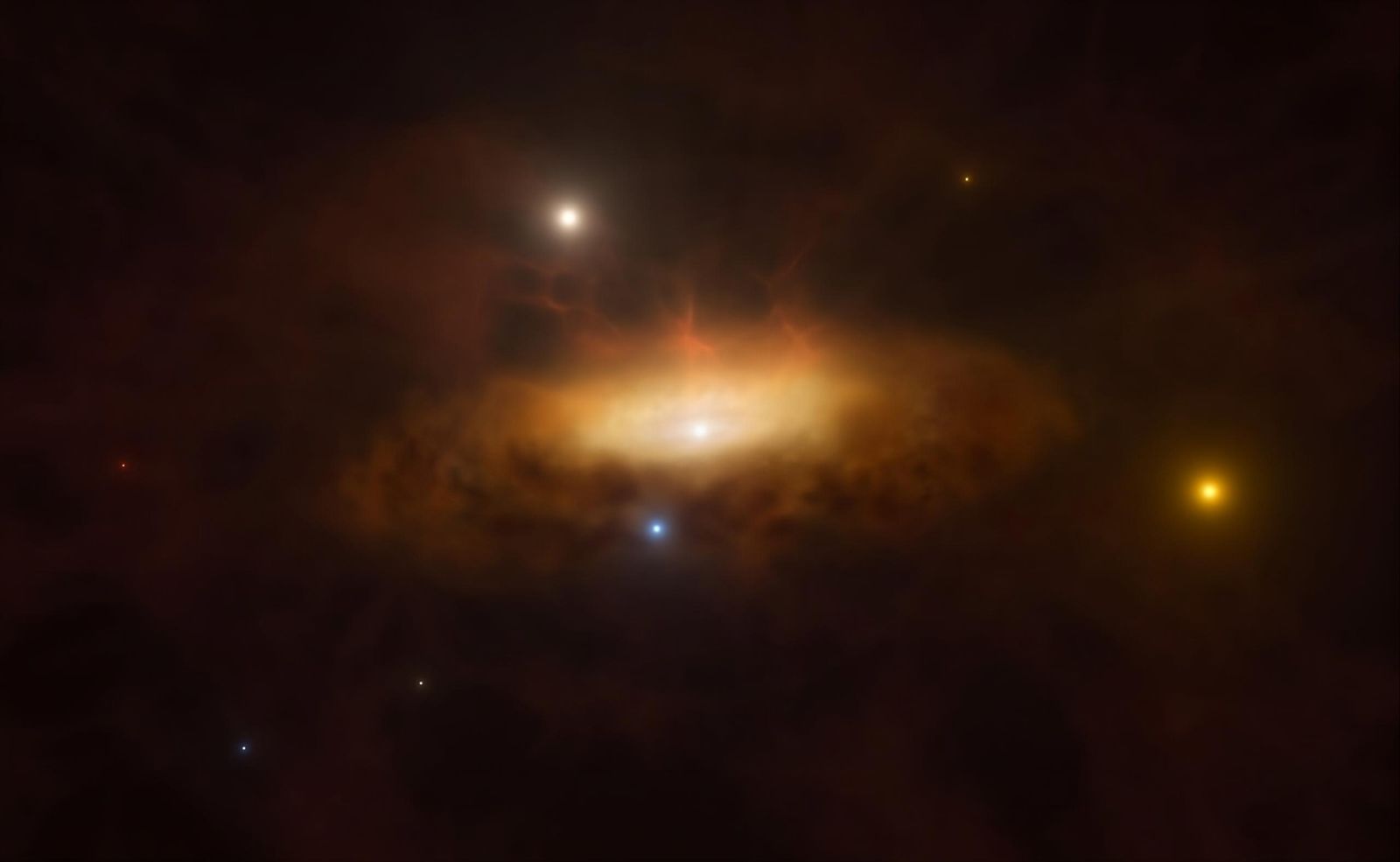Follow us on Google News (click on ☆)

Artist's view: the galaxy SDSS1335+0728 lights up
"Imagine observing a distant galaxy for years that has always appeared calm and inactive," explains Paula Sánchez Sáez, astronomer at ESO in Germany and lead author of the study, whose publication has been accepted in Astronomy & Astrophysics. "Suddenly, its core starts showing dramatic changes in brightness, unlike any typical events we've seen before."
This is what happened to SDSS1335+0728, which is now classified as an "active galactic nucleus" (AGN)—a compact, bright region driven by a massive black hole—after lighting up spectacularly in December 2019 (1).
Certain phenomena, such as supernova explosions or tidal disruptions—when a star gets too close to a black hole and is torn apart—can cause sudden brightening of galaxies. However, such variations in brightness usually last only a few dozen or at most a few hundred days. SDSS1335+0728 continues to shine even today, more than four years after it was first seen "lighting up."
Moreover, the detected variations in the galaxy, located 300 million light-years away in the constellation Virgo, do not resemble any previously observed, suggesting another explanation.
The team sought to understand these brightness variations by combining archival data and new observations from several facilities, including the X-shooter instrument on ESO's VLT in the Atacama Desert in Chile (2). By comparing data taken before and after December 2019, they found that SDSS1335+0728 now emits much more light in the ultraviolet, optical, and infrared wavelengths. The galaxy also began emitting X-rays in February 2024. "This behavior is unprecedented," says Paula Sánchez Sáez, who is also affiliated with the Millennium Institute of Astrophysics (MAS) in Chile.
This animation shows the growth of the matter disk around the massive black hole at the center of the galaxy SDSS1335+0728. In late 2019, this galaxy suddenly started shining brighter than ever before and was classified as having an active galactic nucleus, powered by the central black hole feeding on surrounding matter.
Credit: ESO/M. Kornmesser
Credit: ESO/M. Kornmesser
"The most tangible option to explain this phenomenon is that we are seeing how the [core] of the galaxy starts to show (...) activity," explains Lorena Hernández García of MAS and the University of Valparaíso in Chile, co-author of the study. "If this is the case, it would be the first time we're witnessing the activation of a massive black hole in real time."
Massive black holes—whose mass is over a hundred thousand times that of our Sun—exist at the center of most galaxies, including the Milky Way. "These giant monsters are generally dormant and not directly visible," explains Claudio Ricci of Diego Portales University, also in Chile. "In the case of SDSS1335+0728, we were able to observe the awakening of the massive black hole, which suddenly started feeding on the available gas in its environment, thus becoming very luminous."
"This process (...) has never been observed before," says Lorena Hernández García. Previous studies had reported inactive galaxies turning active after several years, but this is the first time the process itself—the awakening of the black hole—has been observed in real time. Claudio Ricci, who is also affiliated with the Kavli Institute for Astronomy and Astrophysics at Peking University in China, adds: "This is something that could also happen to our own Sgr A*, the massive black hole (...) at the center of our galaxy," but it's not exactly clear how likely that is to happen.
Further observations are necessary to rule out other explanations. It is also possible that we are witnessing an unusually slow tidal disruption or even a new phenomenon. If it is indeed a tidal disruption, it would be the longest and faintest event ever observed. "Regardless of the nature of the variations, [this galaxy] provides valuable information on how black holes grow and evolve," explains Paola Sánchez Sáez. "We hope that instruments like [MUSE on the VLT or those on the future Extremely Large Telescope (ELT)] will be essential in understanding [why the galaxy is shining]."
Notes:
(1) The unusual brightness variations of the galaxy SDSS1335+0728 were detected by the Zwicky Transient Facility (ZTF) telescope in the United States. Subsequently, the group led by the Chilean team Automatic Learning for Rapid Event Classification (ALeRCE) classified SDSS1335+0728 as an active galaxy nucleus.
(2) The team collected archival data from NASA's WISE (Wide-field Infrared Survey Explorer) and GALEX (Galaxy Evolution Explorer), the Two Micron All Sky Survey (2MASS), the Sloan Digital Sky Survey (SDSS), and the eROSITA instrument on the Spektr-RG space observatory of IKI and DLR. Besides ESO's VLT, additional observations were made with the Southern Astrophysical Research Telescope (SOAR), the W. M. Keck Observatory, and the Neil Gehrels Swift Observatory, as well as NASA's Chandra X-ray Observatory.